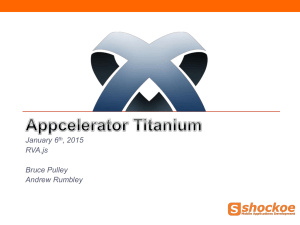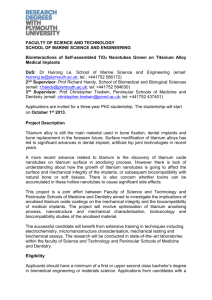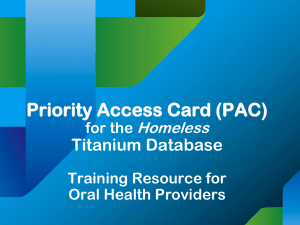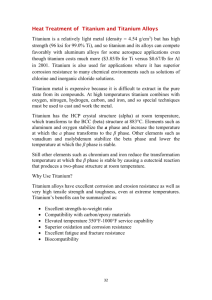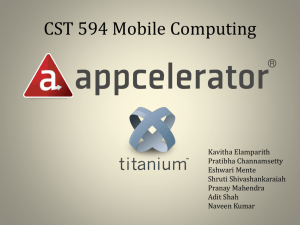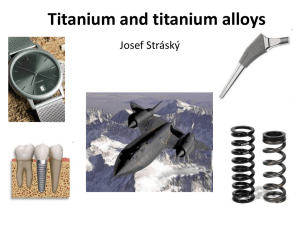Miguel Cordone`s slides (Working with Data), Powerpoint file
advertisement
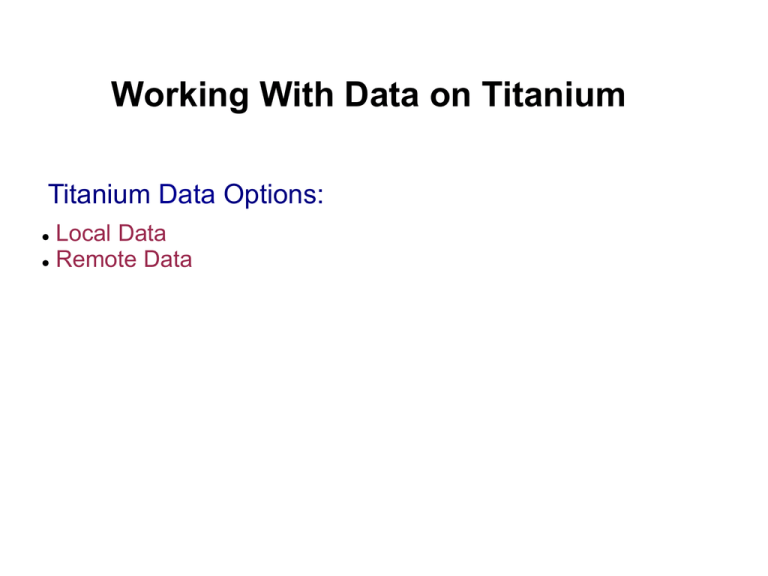
Working With Data on Titanium
Titanium Data Options:
Local Data
Remote Data
Working With Local Data
Titanium Local Storage Options:
Application Properties
Filesystem
Database
To use a device's local storage, the following objects are needed:
* Titanium.App.Properties is ideal for storing application-related settings
* Titanium.Filesystem facilitates file and directory manipulation
* Titanium.Database gives access to local SQLite3 databases
Each of these enable data to persist on a device across application restarts, power cycles,
re-installation and even migration to a new device.
What kind of data storage should I use?
The decision about which of the three local storage options you choose is usually
determined by the following:
1.
Application Properties - used when one or all of the following is true:
* the data consists of simple key/value pairs
* the data is related to the application rather than the user
* the data does not require other data in order to be meaningful or useful
2.
Filesystem - used when one or all of the following is true:
* the data is already provided in file format
* the data is an image file
3. Database - used this when one or all of the following is true:
* there are many similar data items
* items of data relate to each other
* you require flexibility over how the data will be presented when you retrieve it
* the data accumulates over time, such as transaction, logging or archiving data
Application Properties
Reading and Writing Properties
Titanium.App.Properties has six sets of get/set methods for handling six different data types:
getBool() / setBool(): for booleans (true, false)
getDouble() / setDouble(): for double-precision floating point numbers
getInt() / setInt(): for integers
getList() / setList(): for arrays
getString() / setString(): for strings
> See Sample Code
Sample Code result
String: This is a string
Integer: 10
Boolean: true
Double: 10.600000381469727
List:
{ 'address' : '1 Main St'
{ 'address' : '2 Main St'
{ 'address' : '3 Main St'
{ 'address' : '4 Main St'
'name'
'name'
'name'
'name'
:
:
:
:
'Name
'Name
'Name
'Name
1',
2',
3',
4',
},
},
},
},
//JSON OUTPUT
The myJSON property contains: {"reports":[
{"icon":"www.google.com\ig\images\weather\cloudy.gif","condition":"Cloudy
","city":"Mountain View"},
{"icon":"www.google.com\ig\images\weather\mostly_cloudy.gif","condition":
"Cloudy","city":"Washington, DC"},
{"icon":"www.google.com\ig\images\weather\thunderstorm.gif","condition":"
Thunderstorm","city":"Brasilia"}]}
Filesystem Storage
Objects
Titanium.Filesystem is the top level Filesystem module used for reading and saving files
and directories on the device.
Titanium.Filesystem.File is the file object which supported common filesystem based
operations such as create, read, write, delete, etc.
Properties
Data storage locations:
applicationDataDirectory: A read-only constant that indicates where your application
data directory is located. Place application-specific files in this directory.
resourcesDirectory: A read-only constant where your application resources are
located
tempDirectory: A read-only constant that indicates where your application can place
temporary files
Filesystem Storage cont...
Filesystems Methods
getFile(): return a fully-formed file path as a Titanium.Filesystem.File object
read(): return the contents of file as blob
write(): write the contents to file
deleteFile(): delete the file
exists(): return true if the file or directory exists on the device
move(): move the file to another path
rename(): rename the file
nativePath(): return the fully resolved native path
> See Sample Code
SQLite Databases
SQLite3 is version 3 of SQLite's SQL-based relational database management system (RDMS),
chosen by Apple, Google and RIM to provide local data storage on their mobile devices.
Objects
Titanium.Database the top level Database module. The Database module is used for
creating and accessing the in-application Database.
Titanium.Database.DB is the Database instance returned by Titanium.Database.open or
Titanium.Database.install.
Titanium.Database.ResultSet is the ResultSet instance returned by invoking a database
SQL execute.
Database Methods
open(): open a database. if it doesn't yet exist, create it.
execute(): execute a SQL statement against the database and returns a
ResultSet.
close(): close the database and release resources from memory.
SQLite Databases cont...
ResultSet Methods
isValidRow(): return true if the row is a valid row.
fieldByName(): retrieve a row value by field name.
next(): iterate to the next row in the result set. returns false if no more results
are available.
> See Sample Code
Working With Remote Data
Remote Data in Titanium
Your Titanium application can interact with remote servers over HTTP using the
HTTPClient object provided through the Titanium.Network namespace. HTTPClient's API
mirrors that of the XMLHTTPRequest object in the web browser, so if you have done any
Ajax programming in the browser HTTPClient will be familiar to you.
Objects
Titanium.Network.HTTPClient is the HttpClient instance returned from
Titanium.Network.createHTTPClient. This object (mostly) implements the XMLHttpRequest
specification.
HTTPClient Methods
open(): open the request and ready the connection.
send(): send the request (Only async is currently supported).
SetRequestHeader(): set the request header. Must be called after open but
before send.
setTimeout(): set the request timeout.
> See Sample Code
Resources
Working with Local Data:
http://wiki.appcelerator.org/display/guides/Working+with+Local+Data
Working with remote data:
http://wiki.appcelerator.org/display/guides/Working+with+Remote+Data
API Reference Guides:
http://developer.appcelerator.com/apidoc/mobile/latest
